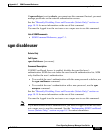
Appendix C SGM Command Reference
sgm gttdir
C-38
Cisco Signaling Gateway Manager User Guide
OL-5742-01
The default GTT Staging Directory is located in the SGM installation directory:
• If you installed SGM in the default directory, /opt, then the directory is
/opt/CSCOsgm/gtt.
• If you installed SGM in a different directory, then the directory is located in
that directory.
Use this command if you want to use a different GTT Staging Directory, such as
/tftpboot, or such as a Network File System location on another server, used as the
TFTP server for server configuration files for ITPs in the network.
Note This command copies all files in the current directory to the new directory. If you
are logged in as the super user, and you do not own the new directory, you might
not be able to copy the files. If that is the case, you must specify a directory that
you own, or you must log in as the root user.
Do not set the new directory to any of the following: /usr, /var, /opt, or /tmp.
Do not set the new directory to the same directory in which you are storing
message log files (sgm msglogdir), report files (sgm repdir), or route table files
(sgm routedir).
When you enter this command, SGM also prompts you to enable TFTP file
transfer for the GTT Staging Directory, and prompts you for the TFTP path for the
directory, tftp://hostname/path, where:
• hostname is the name or IP address of the host on which the GTT Staging
Directory resides.
If you enter a DNS name (such as mwm-jumbo) instead of an IP address
(such as 172.18.12.10), then the ITP must be able to resolve the DNS name.
Otherwise, when you try to deploy a file, SGM issues an appropriate error
message and does not deploy the file.
To enable the ITP to resolve DNS names, enter the ip domain-lookup
command on the ITP. For more information about this command, see the
Cisco IOS IP Command Reference, Volume 1 of 4: Addressing and Services,
Release 12.3 or later.
• path is the path to the GTT Staging Directory.


















